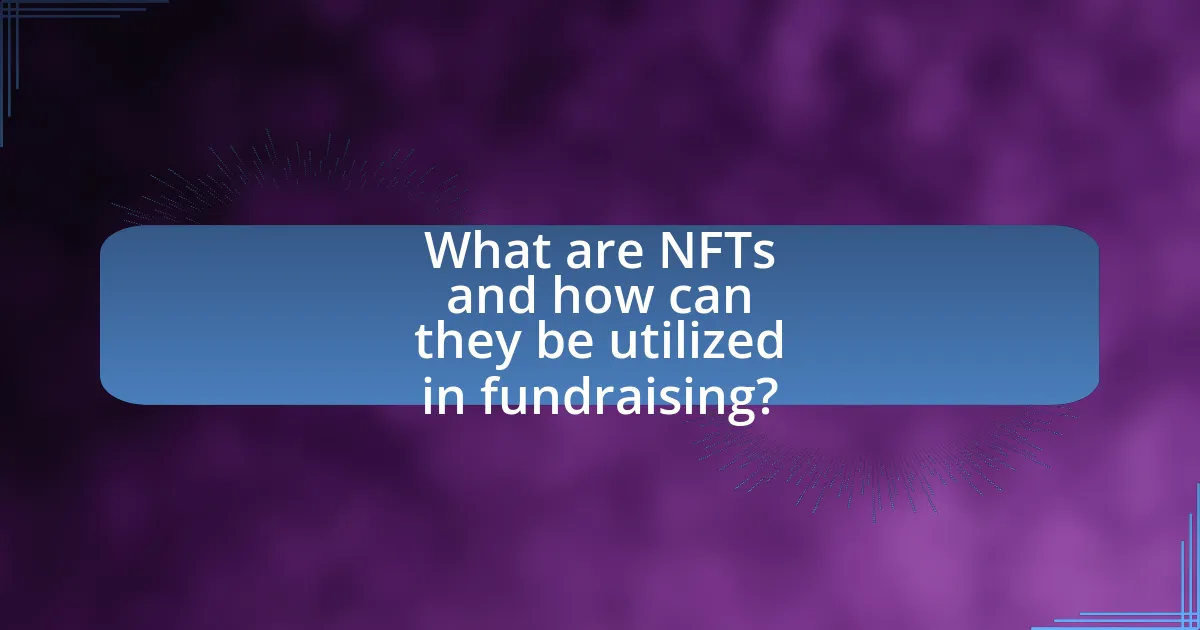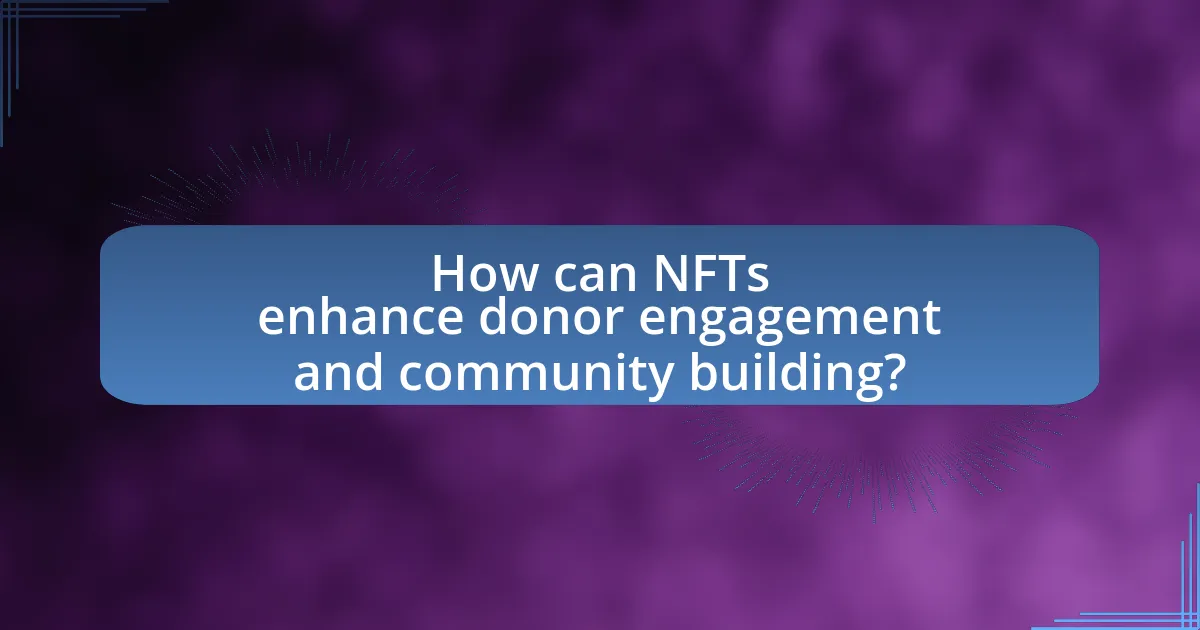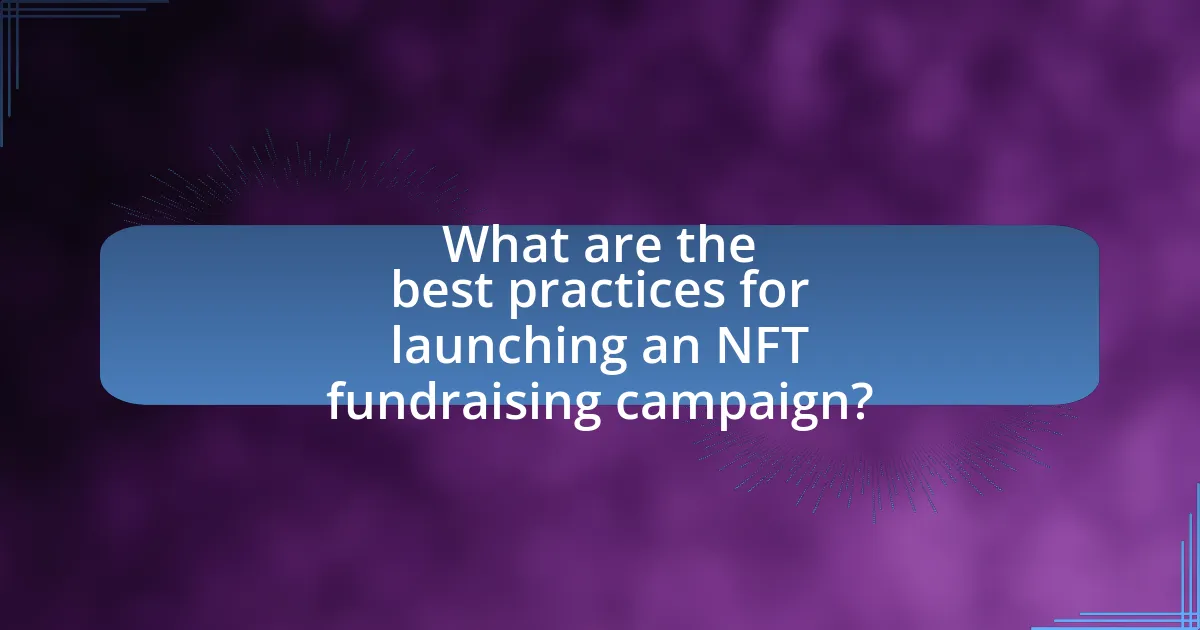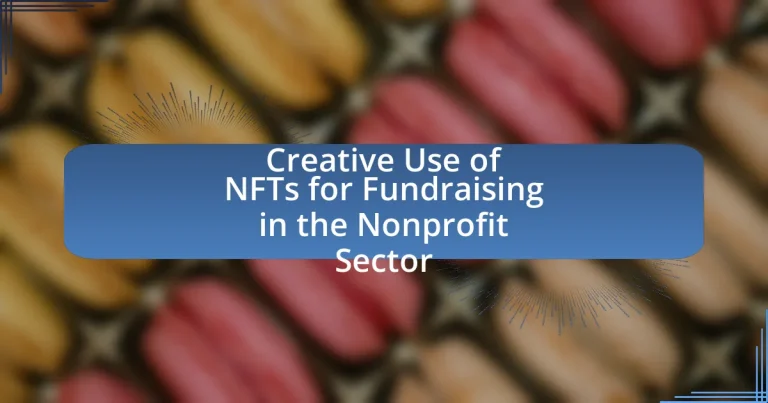The article focuses on the innovative use of Non-Fungible Tokens (NFTs) as a fundraising tool within the nonprofit sector. It explains how NFTs, unique digital assets verified by blockchain technology, can generate revenue through the sale of exclusive digital items, such as artwork and experiences. Key characteristics that make NFTs suitable for fundraising include their uniqueness, verifiability, and potential for community engagement. The article also addresses the differences between NFTs and traditional fundraising methods, the challenges nonprofits face in implementing NFT strategies, and best practices for launching successful NFT campaigns. Additionally, it highlights the importance of storytelling in enhancing donor engagement and the potential long-term benefits of NFTs for donor retention.

What are NFTs and how can they be utilized in fundraising?
NFTs, or Non-Fungible Tokens, are unique digital assets verified using blockchain technology, which ensures their authenticity and ownership. In fundraising, NFTs can be utilized by organizations to create exclusive digital items, such as artwork or experiences, that supporters can purchase or bid on, thereby generating revenue. For example, in 2021, the auction house Christie’s sold an NFT artwork for $69 million, demonstrating the potential for high-value transactions. Nonprofits can leverage this model by offering limited edition NFTs tied to their mission, encouraging donations while providing donors with a collectible asset that may appreciate in value.
How do NFTs function within the nonprofit sector?
NFTs function within the nonprofit sector primarily as innovative fundraising tools that enable organizations to raise money through the sale of unique digital assets. Nonprofits create and sell NFTs, which can represent artwork, experiences, or other digital content, with proceeds directly supporting their missions. For example, in 2021, the nonprofit organization SaveArtSpace sold NFTs of public art to fund community projects, demonstrating how digital assets can generate revenue while engaging supporters. This approach not only diversifies funding sources but also attracts a tech-savvy donor base interested in digital collectibles.
What are the key characteristics of NFTs that make them suitable for fundraising?
The key characteristics of NFTs that make them suitable for fundraising include their uniqueness, verifiability, and ability to create community engagement. NFTs are unique digital assets, meaning each token can represent a distinct item or experience, which can attract donors looking for exclusive contributions. Their verifiability on blockchain technology ensures transparency in ownership and transaction history, fostering trust among potential supporters. Additionally, NFTs can facilitate community engagement by allowing donors to participate in exclusive events or access special content, enhancing their connection to the cause. These characteristics have been leveraged in successful fundraising campaigns, such as the 2021 initiative by the nonprofit organization SaveArtSpace, which raised funds through the sale of NFT art, demonstrating the effectiveness of NFTs in generating financial support for charitable causes.
How do NFTs differ from traditional fundraising methods?
NFTs differ from traditional fundraising methods primarily by enabling direct ownership and unique digital assets for supporters. Unlike traditional fundraising, which often relies on monetary donations without tangible returns, NFTs provide donors with verifiable ownership of digital art, collectibles, or experiences linked to a cause. This ownership can enhance engagement and create a sense of community among supporters. Additionally, NFTs can facilitate ongoing revenue through resale royalties, allowing creators to earn from future transactions, a feature not present in conventional fundraising. This innovative approach has been exemplified by organizations like the World Wildlife Fund, which raised funds by selling NFT art representing endangered species, thus merging fundraising with digital ownership and environmental advocacy.
What innovative approaches are nonprofits using with NFTs?
Nonprofits are utilizing NFTs to create unique digital assets that can be sold or auctioned to raise funds. For instance, organizations like the World Wildlife Fund have launched NFT collections featuring digital art of endangered species, with proceeds directly supporting conservation efforts. Additionally, nonprofits are leveraging NFTs to offer exclusive experiences or memberships, such as virtual meet-and-greets with artists or access to special events, enhancing donor engagement. This innovative use of NFTs not only generates revenue but also raises awareness about the causes they support, exemplified by initiatives like the “NFT for Good” campaign, which showcases how digital assets can drive social impact.
How are nonprofits creating unique NFT offerings for donors?
Nonprofits are creating unique NFT offerings for donors by developing digital art, collectibles, and experiences that reflect their mission and values. For instance, organizations like the World Wildlife Fund have launched NFTs featuring endangered species, allowing donors to own a piece of digital art while supporting wildlife conservation. Additionally, nonprofits are collaborating with artists to produce limited-edition NFTs, which can serve as both a fundraising tool and a way to engage supporters in a novel manner. This approach not only provides donors with tangible digital assets but also fosters a sense of community and connection to the cause, enhancing donor loyalty and engagement.
What types of NFTs are most effective for fundraising purposes?
Artistic NFTs, utility NFTs, and collectible NFTs are the most effective types for fundraising purposes. Artistic NFTs, such as digital artwork, can attract high-value bids from collectors, as seen in the sale of Beeple’s “Everydays,” which sold for $69 million, demonstrating the potential for significant revenue. Utility NFTs offer exclusive access to events or services, incentivizing donations by providing tangible benefits, as evidenced by projects like the “Bored Ape Yacht Club,” which grants members exclusive experiences. Collectible NFTs create a sense of community and ownership, driving engagement and repeat donations, similar to how sports teams leverage collectible NFTs to enhance fan loyalty and fundraising efforts.
What challenges do nonprofits face when implementing NFTs for fundraising?
Nonprofits face several challenges when implementing NFTs for fundraising, including technological barriers, lack of understanding among stakeholders, and regulatory uncertainties. Technological barriers arise from the need for nonprofits to adopt blockchain technology, which may require specialized knowledge and resources that they often lack. Additionally, many stakeholders, including donors and board members, may not fully understand NFTs, leading to skepticism and reluctance to engage. Regulatory uncertainties also pose a challenge, as the legal landscape surrounding NFTs is still evolving, creating potential risks for nonprofits in terms of compliance and liability. These challenges can hinder the effective use of NFTs as a fundraising tool in the nonprofit sector.
How can nonprofits overcome technological barriers related to NFTs?
Nonprofits can overcome technological barriers related to NFTs by investing in education and training for their staff and stakeholders. This approach enables them to understand blockchain technology, digital wallets, and NFT marketplaces, which are essential for successful NFT initiatives. For instance, organizations can partner with tech firms or educational institutions to provide workshops and resources that demystify the technology. Additionally, nonprofits can leverage user-friendly platforms that simplify the creation and sale of NFTs, reducing the technical expertise required. Research indicates that organizations that prioritize digital literacy are more likely to successfully implement innovative fundraising strategies, including NFTs, thereby enhancing their overall effectiveness in fundraising efforts.
What legal considerations should nonprofits be aware of when using NFTs?
Nonprofits should be aware of intellectual property rights, tax implications, and compliance with fundraising regulations when using NFTs. Intellectual property rights are crucial as nonprofits must ensure they have the legal authority to create and sell NFTs based on original works, avoiding copyright infringement. Tax implications arise since the sale of NFTs may be considered taxable income, requiring nonprofits to report earnings accurately. Additionally, compliance with state and federal fundraising regulations is essential, as nonprofits must adhere to laws governing charitable solicitations, which may include disclosures about the use of funds raised through NFT sales.

How can NFTs enhance donor engagement and community building?
NFTs can enhance donor engagement and community building by providing unique digital assets that represent a donor’s contribution, fostering a sense of ownership and connection. By issuing NFTs as rewards for donations, nonprofits can create exclusive experiences or content that incentivizes giving and encourages ongoing participation. For instance, a study by NonFungible.com reported that NFT sales reached $10.7 billion in Q3 2021, indicating a growing interest in digital collectibles. This trend suggests that donors are increasingly motivated by the value and uniqueness of NFTs, which can lead to stronger community ties and increased loyalty to the nonprofit organization.
What role do NFTs play in creating a sense of ownership among donors?
NFTs play a crucial role in creating a sense of ownership among donors by providing them with unique, verifiable digital assets that represent their contributions. This uniqueness and verifiability foster a deeper emotional connection to the cause, as donors can see their specific NFT linked to their donation, enhancing their sense of belonging and investment in the nonprofit’s mission. Furthermore, the blockchain technology underlying NFTs ensures transparency and authenticity, allowing donors to feel secure in their ownership and the impact of their contributions. This combination of uniqueness, emotional connection, and security reinforces the donor’s commitment and engagement with the nonprofit organization.
How can NFTs foster a deeper connection between donors and the nonprofit’s mission?
NFTs can foster a deeper connection between donors and a nonprofit’s mission by providing unique, verifiable digital assets that represent the donor’s support and engagement. These digital tokens can encapsulate the nonprofit’s values, projects, and impact stories, allowing donors to feel a personal stake in the mission. For instance, when donors purchase or receive NFTs tied to specific initiatives, they gain exclusive access to content, updates, or experiences related to those initiatives, enhancing their emotional investment. Research indicates that 64% of NFT owners feel a stronger connection to the causes they support through their digital assets, demonstrating that NFTs can effectively bridge the gap between financial contributions and personal involvement in a nonprofit’s mission.
What are the potential long-term benefits of using NFTs for donor retention?
The potential long-term benefits of using NFTs for donor retention include enhanced engagement, unique value propositions, and community building. NFTs can create a sense of ownership and exclusivity for donors, which fosters a deeper emotional connection to the cause. This emotional investment can lead to increased loyalty and repeat donations over time. Additionally, NFTs can serve as digital collectibles that provide ongoing value, such as access to special events or content, incentivizing donors to remain engaged with the organization. Research indicates that organizations leveraging innovative technologies like NFTs can see a 20% increase in donor retention rates, highlighting their effectiveness in maintaining donor relationships.
How can storytelling be integrated into NFT fundraising campaigns?
Storytelling can be integrated into NFT fundraising campaigns by creating narratives that connect potential donors emotionally to the cause represented by the NFTs. This approach allows organizations to share impactful stories about the beneficiaries, the mission, and the specific projects that the funds will support, thereby enhancing donor engagement. For instance, a nonprofit could develop a series of NFTs that visually represent different aspects of their work, each accompanied by a story that illustrates the real-world impact of donations. Research indicates that emotional storytelling can increase donor retention rates by up to 50%, demonstrating its effectiveness in fundraising efforts.
What strategies can nonprofits use to effectively tell their story through NFTs?
Nonprofits can effectively tell their story through NFTs by creating unique digital assets that represent their mission and impact. These assets can include artwork, videos, or interactive experiences that resonate with their audience. By leveraging storytelling techniques, nonprofits can embed narratives within the NFTs, showcasing real-life stories of beneficiaries or highlighting specific projects.
For instance, a nonprofit focused on environmental conservation could create an NFT that features a digital artwork of a protected area, accompanied by a narrative about its significance and the ongoing efforts to preserve it. This approach not only engages potential donors but also fosters a deeper emotional connection to the cause.
Additionally, nonprofits can utilize social media and online platforms to promote these NFTs, reaching a broader audience and encouraging community participation. Collaborating with artists or influencers can amplify their message, as seen in successful campaigns where artists donate proceeds from NFT sales to charitable causes. This strategy not only raises funds but also raises awareness about the nonprofit’s mission, making the storytelling more impactful.
How does storytelling impact the perceived value of NFTs for donors?
Storytelling significantly enhances the perceived value of NFTs for donors by creating emotional connections and contextualizing the purpose behind the digital assets. When nonprofits utilize storytelling, they can effectively communicate the mission, impact, and personal narratives associated with the NFTs, making them more relatable and meaningful to potential donors. Research indicates that emotional engagement can increase willingness to donate; for instance, a study published in the Journal of Nonprofit & Public Sector Marketing found that narratives that evoke empathy lead to higher donation amounts. This demonstrates that storytelling not only enriches the donor experience but also elevates the perceived worth of NFTs as vehicles for supporting charitable causes.

What are the best practices for launching an NFT fundraising campaign?
The best practices for launching an NFT fundraising campaign include defining a clear purpose, engaging the community, creating unique and valuable NFTs, leveraging social media for promotion, and ensuring transparency in the fundraising process. A clear purpose helps potential donors understand the impact of their contributions, while community engagement fosters trust and interest. Unique NFTs can attract buyers, as they offer something special that cannot be found elsewhere. Social media platforms are effective for reaching a wider audience and generating buzz around the campaign. Transparency about how funds will be used builds credibility and encourages more donations. These practices are supported by successful campaigns that have demonstrated increased engagement and funding through strategic planning and execution.
How should nonprofits prepare for an NFT fundraising initiative?
Nonprofits should prepare for an NFT fundraising initiative by developing a clear strategy that includes defining their goals, identifying target audiences, and selecting appropriate NFT platforms. A well-defined strategy ensures that the initiative aligns with the organization’s mission and engages potential donors effectively. Additionally, nonprofits must educate themselves about blockchain technology and NFTs to communicate their value to supporters. Research indicates that 64% of nonprofits that adopt innovative fundraising methods, like NFTs, see increased donor engagement. By leveraging this knowledge, nonprofits can create compelling NFT offerings that resonate with their audience and drive contributions.
What steps are involved in creating and marketing NFTs for fundraising?
Creating and marketing NFTs for fundraising involves several key steps. First, identify a unique concept or artwork that resonates with your target audience and aligns with your fundraising goals. Next, choose a blockchain platform, such as Ethereum or Polygon, to mint the NFT, ensuring it supports the necessary features for your fundraising campaign. After minting, create a compelling narrative around the NFT, highlighting its significance and the cause it supports, which can enhance its appeal to potential buyers.
Subsequently, establish a marketing strategy that includes social media promotion, partnerships with influencers, and email campaigns to reach a broader audience. Utilize platforms like OpenSea or Rarible to list the NFT, making it accessible for purchase. Finally, engage with the community post-sale to maintain interest and transparency about how the funds will be used, reinforcing trust and encouraging future support. These steps are essential for effectively leveraging NFTs in fundraising efforts.
How can nonprofits measure the success of their NFT fundraising efforts?
Nonprofits can measure the success of their NFT fundraising efforts by analyzing key performance indicators (KPIs) such as total funds raised, number of NFTs sold, and engagement metrics. For instance, tracking the total revenue generated from NFT sales provides a direct measure of financial success, while the number of NFTs sold indicates market interest and demand. Additionally, engagement metrics, such as social media shares and comments related to the NFT campaign, can reflect community involvement and awareness. According to a report by NonFungible.com, NFT sales in the nonprofit sector have seen significant growth, with some organizations raising millions through successful campaigns, underscoring the effectiveness of these metrics in evaluating success.
What tips can nonprofits follow to maximize their NFT fundraising potential?
Nonprofits can maximize their NFT fundraising potential by creating unique digital assets that resonate with their mission and audience. Engaging storytelling around the NFTs can enhance emotional connections, encouraging potential donors to participate. Additionally, leveraging social media platforms for promotion can significantly increase visibility and reach, as evidenced by the success of various nonprofits that have utilized platforms like Twitter and Instagram to showcase their NFT campaigns. Collaborating with artists or influencers who align with the nonprofit’s values can also attract a broader audience, as seen in successful partnerships that have led to increased donations. Finally, providing clear instructions on how to purchase and support through NFTs can streamline the process, making it easier for donors to contribute.
How can nonprofits leverage social media to promote their NFT campaigns?
Nonprofits can leverage social media to promote their NFT campaigns by creating engaging content that highlights the unique aspects of their NFTs and the impact of their fundraising efforts. By utilizing platforms like Twitter, Instagram, and Facebook, nonprofits can share visually appealing graphics, videos, and stories that resonate with their audience, encouraging shares and interactions. For instance, a study by the Pew Research Center indicates that 69% of adults in the U.S. use social media, making it a powerful tool for reaching potential supporters. Additionally, nonprofits can collaborate with influencers in the NFT space to expand their reach and credibility, as influencer marketing has been shown to increase engagement rates significantly.
What partnerships can enhance the visibility and impact of NFT fundraising efforts?
Strategic partnerships with established brands, influencers, and platforms can significantly enhance the visibility and impact of NFT fundraising efforts. Collaborating with well-known brands can leverage their audience reach, as seen in initiatives where companies like Adidas and Nike have successfully integrated NFTs into their marketing strategies, resulting in increased engagement and donations. Partnering with influencers who have a strong presence in the NFT and cryptocurrency space can also amplify outreach, as their endorsements can attract a dedicated following interested in supporting charitable causes. Additionally, aligning with NFT marketplaces, such as OpenSea or Rarible, can provide a dedicated platform for fundraising, ensuring that the NFTs reach a broader audience of potential buyers and supporters. These partnerships create a synergistic effect, driving both visibility and financial contributions to nonprofit initiatives.


